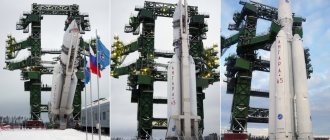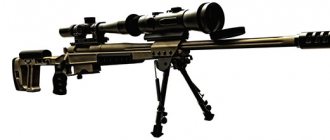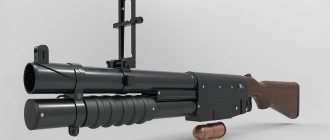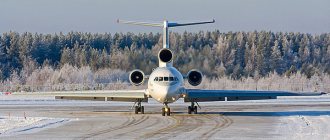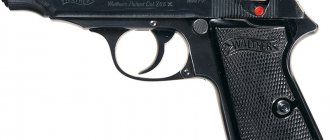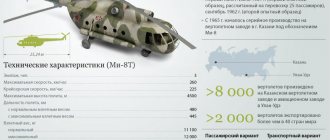History of the creation of the S-500 “Prometheus” air defense system (55Р6М “Triumfator-M”)
The Russian complex (SAM) S-500 “Prometheus”, also called 55R6M “Triumfator-M”, began to be developed by Russian scientists in 2002 as a new generation anti-aircraft missile system (fifth generation SAM). The key feature of this mobile air defense system was supposed to be the interception of ballistic missiles at high altitudes and distances, but the designers also provided for the possibility of hitting air targets.
The original name of the Russian S-500 "Prometheus" (55Р6М "Triumfator-M") air defense system was "Vlastelin", however, after the completion of the research phase, a different name was chosen.
In mid-2011, a preliminary prototype of the S-500 “Prometheus” air defense system (55Р6М “Triumfator-M”) was created, after which the designers began the actual process of creating a unique air and missile defense system.
It was initially assumed that the S-500 “Prometheus” would be put into service in 2016, however, later, this date was decided to be postponed to 2022, however, due to the requirements of Vladimir Putin, the complex began to be more actively tested, which made it possible to bring the date of adoption closer S-500 "Prometheus" air defense system to the troops.
Complex S-500 “Prometheus” (55Р6М “Triumfator-M”) description
The Russian complex S-500 "Prometheus" (55Р6М "Triumfator-M") includes:
- Combat control point 85Zh6-1;
- Early warning radar 60K6;
- Anti-aircraft unit: KP 55K6MA, radar 91N6AM, PU 51P6M, missiles 40N6M;
- Anti-missile unit: PBU 85Zh6-2, radars 76T6 and 77T6 with an active phased antenna array, PU 77P6 and anti-missiles 77N6-N and 77N6-N1.
The detection radius of air targets and ballistic missiles for the S-500 Prometheus air defense system (55Р6М Triumphator-M) is 800 kilometers, while long-range missiles can hit air targets at distances of up to 600 kilometers.
According to analysts, the S-500 Prometheus air defense system can hit air targets at altitudes of up to 200 kilometers, which makes it possible to destroy even low-orbit spacecraft.
American analogue of "Patriot"
Currently, there are two anti-missile systems in the world that are relatively similar in their performance characteristics - the Russian Federation and the United States. In Russia, this is currently the S-400, and the American Patriot-3 complex is recognized by many foreign experts as the best in service in the world. It can “reach” a target at an altitude of up to twenty-four kilometers at a distance of up to five hundred kilometers. Its only known drawback is low cross-country ability.
If you have any questions, leave them in the comments below the article. We or our visitors will be happy to answer them
Anti-aircraft missile system S-400 "Triumph"
The fruit of the work of the united air defense holding Almaz-Antey raises many questions. The main one is what does an ultra-long-range missile look like and what is it, capable, as the Air Force command assures, of hitting targets at a distance of 400 km?
But first things first. Let's take a brief excursion into the history of the creation of the S-300 air defense system for the air defense of the Soviet Army (this means air defense forces, air defense forces of the ground forces, and the navy).
The development of the S-300 universal multi-channel air defense system for the USSR Armed Forces began in 1969. The task was to unify as much as possible or even create a single air defense system for air defense, ground forces and navy (S-500U), but this was not achieved. Almost immediately, work began along the lines of two design bureaus - Almaz (missile developer - MKB Fakel, Khimki) began developing the S-300P system on wheeled chassis for the country's air defense forces, and on its basis the Reef system for surface ships first rank of the Navy, and the creation of the S-300V air defense system with the placement of combat and auxiliary elements on tracked chassis for the ground forces was undertaken by the Antey enterprise (missile developer - Novator Design Bureau, Sverdlovsk). It immediately became clear that these systems would be completely different both in execution and in combat capabilities.
The S-300P was supposed to cover large administrative, industrial and military centers of the country from enemy aircraft and cruise missiles, and the S-300B system, in addition to these tasks, was supposed to have certain anti-missile capabilities, in particular, to cover ground forces formations from operational-tactical attacks ballistic missiles of the Lance and Pershing-1 classes, and in the future from the Pershing-2 medium-range missiles.
The S-300P system was put into service in 1979, the S-300V in full combat configuration (with 9M82 anti-missile missiles) - in 1989.
Evolution of the S-300P - Biryusa and Volkhov M-6
In this material, we will analyze the development of the S-300P air defense system regarding its weapons, that is, anti-aircraft missiles.
The basic version of the S-300P was equipped with a 5V55K missile defense system (5 transport-launch containers with missiles were placed on the towed launcher). Testing of the system's equipment at the Sary-Shagan test site began with the launch of the 5V55.2T rocket prototype No. 1. The launch took place on March 4, 1970 from a temporary launch position.
The S-300PT Biryusa was the first modification with four missiles standard for this type of air defense system (the missile range was only 47 km). Later, 5V55R missiles with a range increased to 75 km, as well as 5V55S missiles with a nuclear warhead, appeared on this air defense system. The same missiles were equipped with improved air defense systems of the S-300PT-1 and S-300PT-1A types.
The S-300PS Volkhov M-6 air defense system on the MAZ-543M (5P85SM) chassis, which was put into service in 1983, became a deep modernization. The range of hitting targets on this complex was increased to 90 km.
An even more advanced modification was the S-300PM Volkhov M-6M air defense system with missiles capable of hitting targets at a range of up to 150 km. On its basis, the export version of the S-300PMU1 “Volkhov M-6M” was created. This option is currently the most common among the country's air defense forces. In the 80s, serial production of air defense systems of the S-300P and PT series reached 50 complexes and 3000 missiles per year. By 1988, the country's air defense forces had more than 150 units equipped with S-300P, PT, PS and PM air defense systems. According to Western estimates, the number of launchers of this type reached 1,500 units.
Let's move on to rockets. With a length of 7.25 m, the mass of the 5V55K and R missile defense systems was 1480 and 1665 kg, respectively (the difference from the amount of fuel and the mass of the warhead). According to some data, the starting thrust of the solid propellant rocket engine is 25 tf, the engine runs for 9 seconds, and during this time the missile launcher accelerates to 2000 m/s.
The S-300PM and PMU-1 are equipped with more powerful 48N6 missiles, which are a further development of the 5V55 series missiles. The weight and size characteristics of the missiles have remained virtually unchanged and are housed in the same TPKs as the 5V55 series missiles. But their performance characteristics have been significantly improved, the range of hitting targets has reached 150 km.
S-300PMU-2 “Favorit”
This complex is equipped with even more powerful 48N6E2 missiles with a firing range of up to 200 km. According to the Krasnaya Zvezda newspaper, an important feature of the Favorit air defense system is that it is easily integrated into various air defense systems of foreign countries. “Favorit” is capable of hitting air targets at ranges from 3 to 200 km in the altitude range from 0.01 to 27 km, including ballistic missiles with a launch range of up to 1,000 km by physically destroying warheads at ranges of up to 40 km. The speed of the targets hit is up to 2,800 m/sec. The air defense system is capable of simultaneously firing at up to six targets, aiming up to two missiles at each target. Rate of fire 3 – 5 sec.
8 divisions of Favorit were delivered to China.
S-400 "Triumph"
A radical modernization was the S-400 Triumph air defense system.
Its main difference from the base generation systems was the equipment with completely new anti-aircraft missiles with reduced weight and size characteristics.
The 9M96E2 type missile defense system is considered more powerful, with a firing range of 120 km and a strike height of 5 m to 30 km, and a weight of 420 kg. The time it takes to prepare a missile for launch when it is on the launcher is no more than 8 seconds. The assigned service life is 15 years. This period may be extended after technical examination of 9M96E2 at the places of their operation.
The 9M96E missile differs from the 9M96E2 in its characteristics and is practically similar to the Buk-M1 medium-range air defense missiles. The target engagement range is 40 km, the engagement height is 20 km, and the mass is 333 kg. The engine power of the 9M96E is less than that of the 9M96E2, but they are almost the same in size and weight.
9M96E and 9M96E2 are completely unified in terms of on-board equipment, combat equipment (warhead weighing 24 kg) and design.
Launchers of the S-400 Triumph air defense system are very diverse. They can be equipped with either 4 48N6 series missiles or a combination of missiles - three 48N6E missiles and four 9M9E/E2 missiles. This combination of missiles with ranges of 200, 120 and 40 km, respectively, makes it possible to create a weapon system with different echelons for intercepting targets, including both aerodynamic and ballistic ones.
A launcher was developed on the basis of a KAMAZ vehicle with 12 missiles of the 9M96E/E2 type. Thus, the S-400 Triumph, equipped with three different types of missiles, is today unique in its class.
Ultra-long-range missiles for the S-400 "Triumph"
But, of course, the greatest intrigue is the equipping of this type of air defense system with a certain missile with a range of 400 km, which has been repeatedly reported in the press.
What kind of rocket is this? It is known that the self-propelled launcher of this system can accommodate four such ultra-long-range missiles. It was reported that the development of this missile is being carried out by the Fakel design bureau. The missile is designed to replace the stationary S-200D Dubna air defense systems with a range of up to 300 km. Such a huge range is achieved thanks to the use of A-50 long-range radar detection and control aircraft in the S-400 system and equipping the missile defense system with an active homing head, which allows the missile to be aimed beyond the visibility of ground-based radars and the aircraft AWACS system. The SAM index is still unknown.
In 2005, NVO reported that this rocket was 82% ready, but due to financial difficulties, the creation of this rocket was actually suspended. But the Air Force command assures that such a missile has been created and that its tests have been successfully carried out. The first S-400 systems should enter service with the Moscow Air Defense District (Elektrostal area) in the summer of 2007 and should complement the Moscow missile defense system, equipped with 53T6 silo-based anti-missile systems.
So far, there is no reliable information on the presence of this missile in the S-400 Triumph weapon system, just as there are no photos of the missile defense system in the open press.
"Autocrat"
The same NVO publication provides data that instead of the missile defense system being developed at the Fakel design bureau, in the S-400 system, the Air Force command plans to use an improved 9M82 missile defense missile system of some modification - a component of the Antey-ground forces air defense system that has not yet been adopted into service. 2500" (S-300VM), created on the basis of the well-known S-300V air defense system. The fact is that the unification of the Almaz and Antey organizations into a single corporation allegedly prompted their developers to create a kind of hybrid of two systems - the S-400 Triumph and Antey-2500.
The launcher based on the KRAZ-260V all-terrain vehicle is equipped with two modernized 9M82M missile defense systems. It is not known whether such powerful missiles have been tested from a car chassis, but again the Air Force command assures that this system is a reality. We have to take their word for it, since no photos were presented in the open press, at least the author of these lines does not know about it yet (see pictures and NATO classification, taken from the Australian military website https://www.ausairpower.net /APA-Grumble-Gargoyle.html).
| Russian Designation | Original Design | Revised Design | Notes |
| S-300P/PT | SA-10A Grumble A | SA-10A Grumble A | |
| S-300PS | SA-10B Grumble B | SA-10B Grumble B | |
| S-300PMU | SA-10C Grumble C | SA-10C Grumble C | |
| S-300PMU-1 | SA-10D Grumble D | SA-20A Gargoyle A | |
| S-300PMU-2 Favorit | SA-10E Grumble E | SA-20B Gargoyle B |
Recently, RIA Novosti published a note in which it claims that the S500 Prometheus has already been created and this newest missile defense system will finally eliminate nuclear parity between the United States and Russia. The Americans do not have missile defense systems capable of shooting down our Yars and Bulava. And now there will be no means of delivering nuclear warheads that could penetrate Russia’s missile defense shield.
The S500 is a state-of-the-art and, along with Project 4202, Russia's most secret military program. Its goal is the complete elimination of parity of nuclear forces with the United States. It includes the latest MARS target detection system, a combat control point, and the latest active phased array radar. But the main thing is an anti-missile missile, which is capable of hitting not only ballistic and aerodynamic missiles, but also hypersonic cruise missiles at a range of 600 km. Moreover, officially at an altitude of up to 100 km (up to the Karman line). Or maybe higher - who knows?
Imagine a rocket flying at a speed of 1.8-2.5 km per second? Introduced? That is, in a minute such a rocket is capable of flying 108-150 kilometers. And our newest S500 Prometheus air defense system is already capable of shooting down such a missile. But such missiles are not in service with the United States, NATO countries, or other nuclear powers and are not expected in the next 20 years.
The Americans are just beginning to develop the latest LRSO missile for strategic containment of Russia and China. The details of this program are, of course, classified, but data about the possible parameters of the new promising rocket is leaking to the press: the LRSO flight range will be at least 3-3.5 thousand kilometers with an average speed of about 800 kilometers per hour. But this is too little to slip past the C500. In addition, this rocket in the United States is going to be created only by 2022, and possibly later. And a couple more years to organize mass production. And the nuclear weapons delivery systems existing in the West cannot bypass even the currently existing S400 Triumph complexes, which are much inferior in all respects to the Prometheus.
“The S-500 will be able to carry out not only tasks within the framework of air defense, but, in fact, will already be an element of missile defense,” V. Putin said at a meeting on the development of the military space defense system.
For the development of the S500, the creators of this most complex military equipment received high awards, incl. Druzin S.V. - Head of the Department for Scientific and Technical Development of Almaz-Antey, Order of Merit for the Fatherland, second degree. Drize I.M. — received the honorary title “Honored Designer of Russia.” Gorbachev M.A., a classified scientist and chief specialist at Almaz-Antey, also received this title. And a whole team of specialists, scientists, managers who participated in the creation of this real breakthrough in engineering and technology.
“As part of the rearmament program until 2022. A serious government order for aerospace defense equipment is expected. In two to three years, production volumes can increase for individual samples from 10 to 100 times. It is very difficult to increase existing capacities in the conditions of existing enterprises by 10 times. It’s easier to build new ones,” said S. Ostapenko, Deputy General Director of Almaz-Antey Air Defense Concern OJSC, in March 2012, noting that production at new facilities is planned to begin in 2015.
According to data from trusted sources, both plants - both in Kirov and in Nizhny Novgorod, are in a high degree of construction readiness, finishing work and commissioning of individual technological equipment are underway. So, there is hope that if not in 2016, then already in 2022, the first batches of Prometheus will roll off the assembly line. And this will mean the end of nuclear deterrence parity.
Speaking of sanctions. The Almaz-Antey air defense concern, which came under US sanctions due to the situation around Ukraine, does not expect large-scale problems. This was stated by the general director of the concern, Yan Novikov. “US sanctions will not have a noticeable impact on the full implementation of the plans of the Almaz-Antey air defense concern to develop and create promising types of air defense and missile defense weapons,” he said.
S 500 Missile system of the future
Deputy General Director of the Almaz-Antey concern for foreign economic activity, Vyacheslav Dzirkaln, announced the imminent completion of tests of the S-500 anti-aircraft guided missile system, which is designed to intercept targets in the upper layers of the atmosphere.
He explained that individual elements of Prometheus “successfully passed the main part of the tests.”
“According to the plan, the transfer of the system is scheduled for 2022,” Dzirkaln said at the International Aviation and Space Salon (MAKS-2017), which is taking place these days in Zhukovsky near Moscow.



